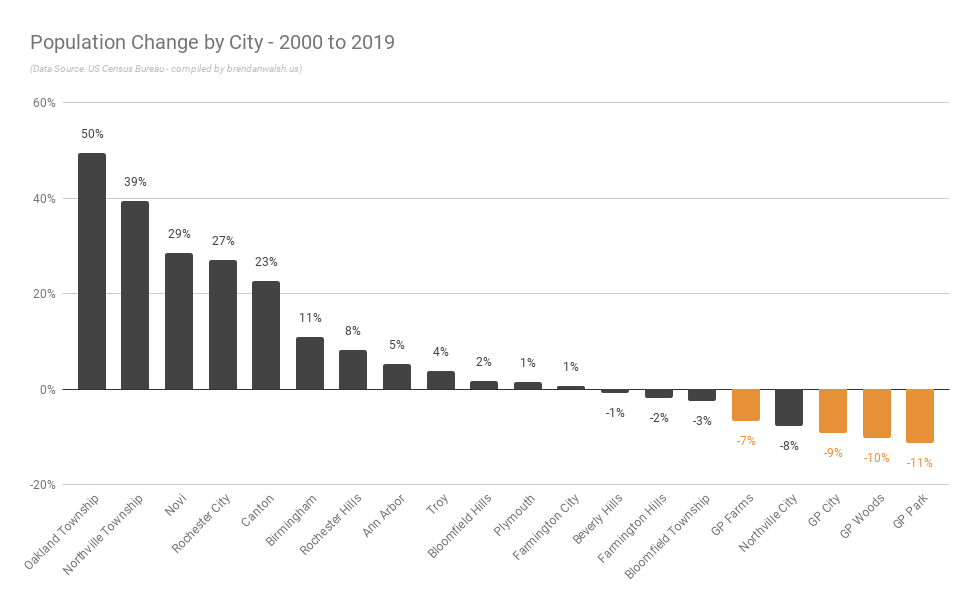This “Benchmark Project” (intro here) compares financial, demographic, and census data from ten Metro Detroit, upper-middle class suburban cities and school districts: Ann Arbor, Birmingham, Bloomfield, Farmington, Grosse Pointe, Northville, Novi, Plymouth-Canton, and Troy.
When I served on the Grosse Pointe School Board (2005 – 2013), legendary superintendent Dr. C. Suzanne Klein, when helping navigate difficult issues used the clarifying question, “What problem are we trying to solve?”
That’s the right question now for the Grosse Pointe Public School System as well as the cities with whom the district is inexorably partnered.
Where does the influence of a community on its school district end and the influence of a school district on a community begin? No easy task, but I have started piecing together tax, home value, school enrollment, and scores of demographic data – all of which I am eager to explore and share.
But to answer Dr. Klein, I propose we start here – the population change by benchmark city between 2000 and 2019. Wearing our Grosse Pointer hat, I think the problem begins with adverse population trends.

The Proposal A Era began in Michigan in 1995 so the chart above is the majority of that era, showing the communities that enjoyed growth through most or all of it. In reality, there’s a before and after period within this data as growth was substantially higher before The Great Recession. For fellow data geeks, I created this view as well to see if it gives us anything more to chew on. My hypothesis now is that in Grosse Pointe we have just been a a long-term steady decline while other communities still grow, but at a slower pace than the oughts.

If a community’s population is growing all kind of good things are happening – such as more demand for housing so critical to tax revenues for cities and home values for homeowners. Or with more residents (typically) comes rising school enrollment so critical to Michigan’s per pupil funding model. Growth can bring its own challenges, but they are challenges one is happy to embrace.
Contraction is a horse of a different color.
Once an entity (business, city, school district) begins to contract, all the gears of scaled growth are abruptly thrust into reverse, grinding and breaking from the force. The spending and tax protections that governed growth become a minefield as you track back.
A big picture view of the Grosse Pointe communities’ data indicates a unique problem relative to other similar communities. How do we break it down and solve it?
One suggestion is to avoid the tendency to view the cities and the schools in isolation — logical considering the literal segmentation of the Grosse Pointe municipalities. But despite geographically parochial views of literally North and South, these population changes suggest that the Park, City, Farms, and Woods population trends are directionally consistent with one another, but dangerously out of step with most the other benchmark communities.
In ensuing posts, I will bring forward additional data that may help diagnose the issues, which will undoubtedly be complex. As Grosse Pointers we ought to frame our approach as Dr. Klein would. If pressed for a hypothesis right now to identify the biggest problem both the schools and communities face, I suggest it’s these long-term population trends.
Unfortunately identifying the problem is the easier part of this endeavor and we’ll examine more data to help us.

2 responses to “Benchmark Project: What Problem Are We Trying to Solve?”
With Detroit (seemingly) beginning to get back to growth, I wonder if that will start to provide some momentum for the Pointes.
Hi Tim, thanks for reading and commenting. I agree that Detroit’s newfound growth stands as a great promise for the GP’s, especially the Park. All the more reason why we ought to be looking at this kind of data since all the communities are more or less Detroit suburbs. If the GP communities don’t experience the same kind of gains as the other benchmark communities, we ought to be very concerned.
Brendan